Corporate Social Responsibility & Leadership
VerifiedAdded on 2020/04/01
|13
|3205
|967
AI Summary
This assignment explores the crucial relationship between leadership and corporate social responsibility. It delves into how leaders can influence the creation, implementation, and sustainability of socially responsible firm behaviors. The text discusses various aspects of CSR, including ethical decision-making, environmental sustainability, and stakeholder engagement. Additionally, it highlights the impact of different leadership styles on CSR performance and provides insights into best practices for integrating CSR into organizational culture.
Contribute Materials
Your contribution can guide someone’s learning journey. Share your
documents today.
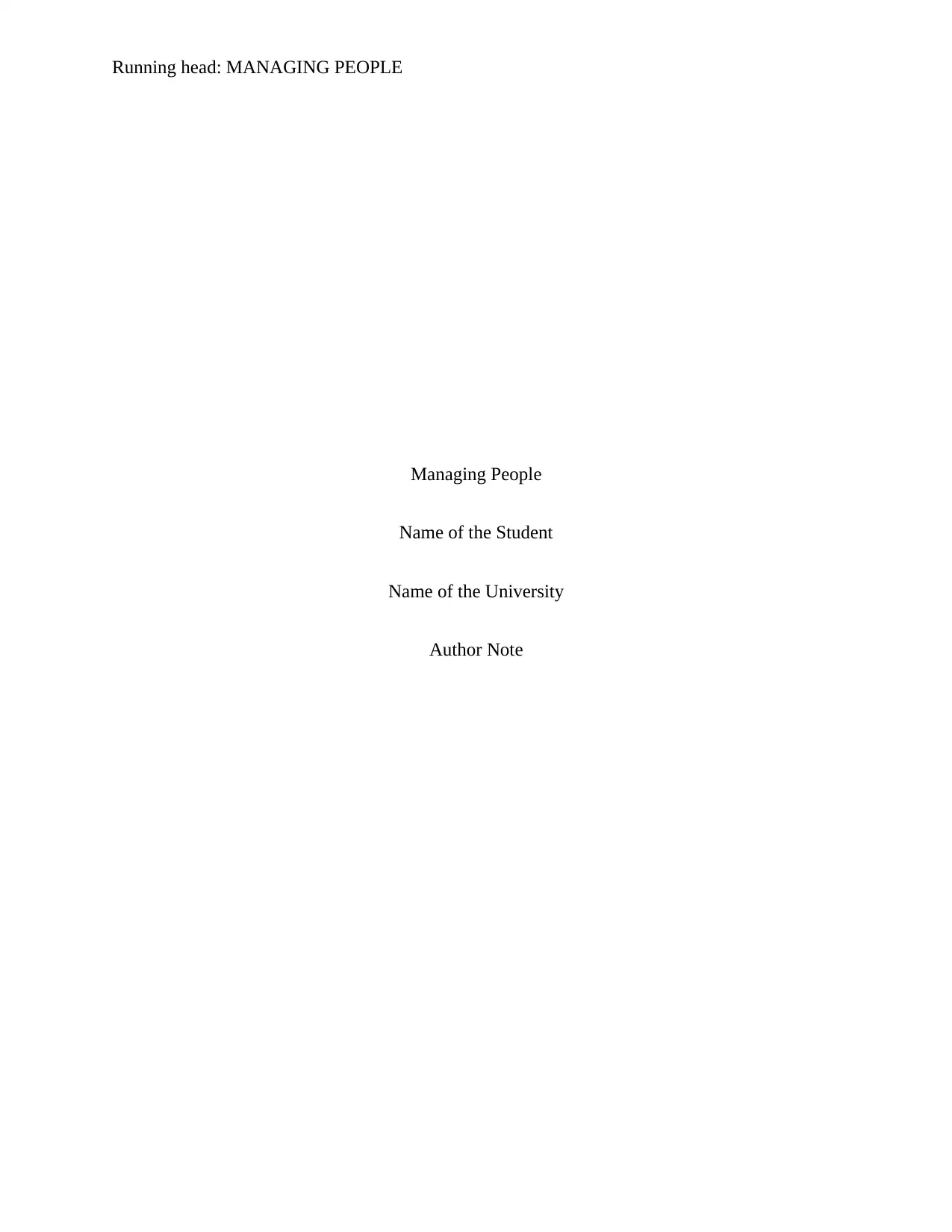
Running head: MANAGING PEOPLE
Managing People
Name of the Student
Name of the University
Author Note
Managing People
Name of the Student
Name of the University
Author Note
Secure Best Marks with AI Grader
Need help grading? Try our AI Grader for instant feedback on your assignments.
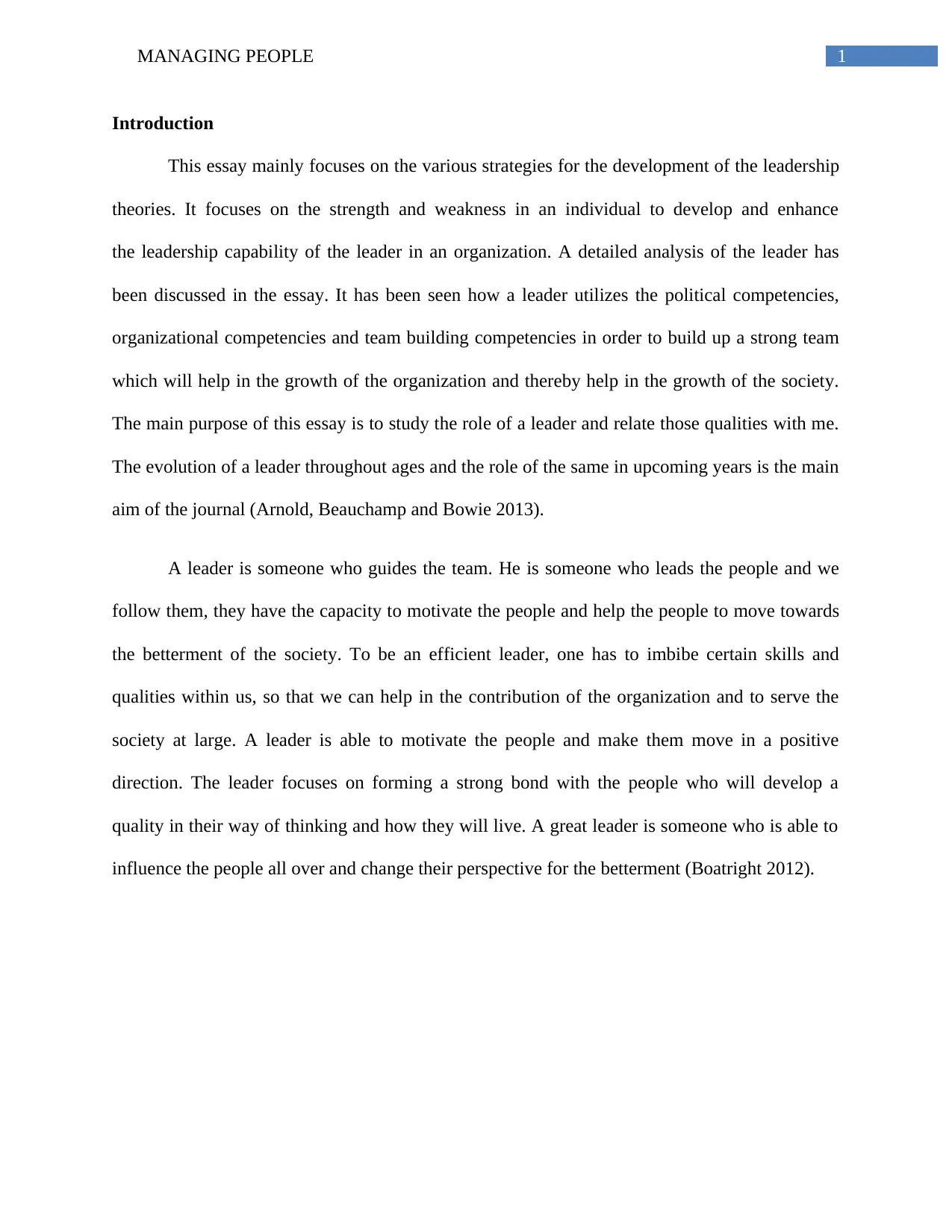
1MANAGING PEOPLE
Introduction
This essay mainly focuses on the various strategies for the development of the leadership
theories. It focuses on the strength and weakness in an individual to develop and enhance
the leadership capability of the leader in an organization. A detailed analysis of the leader has
been discussed in the essay. It has been seen how a leader utilizes the political competencies,
organizational competencies and team building competencies in order to build up a strong team
which will help in the growth of the organization and thereby help in the growth of the society.
The main purpose of this essay is to study the role of a leader and relate those qualities with me.
The evolution of a leader throughout ages and the role of the same in upcoming years is the main
aim of the journal (Arnold, Beauchamp and Bowie 2013).
A leader is someone who guides the team. He is someone who leads the people and we
follow them, they have the capacity to motivate the people and help the people to move towards
the betterment of the society. To be an efficient leader, one has to imbibe certain skills and
qualities within us, so that we can help in the contribution of the organization and to serve the
society at large. A leader is able to motivate the people and make them move in a positive
direction. The leader focuses on forming a strong bond with the people who will develop a
quality in their way of thinking and how they will live. A great leader is someone who is able to
influence the people all over and change their perspective for the betterment (Boatright 2012).
Introduction
This essay mainly focuses on the various strategies for the development of the leadership
theories. It focuses on the strength and weakness in an individual to develop and enhance
the leadership capability of the leader in an organization. A detailed analysis of the leader has
been discussed in the essay. It has been seen how a leader utilizes the political competencies,
organizational competencies and team building competencies in order to build up a strong team
which will help in the growth of the organization and thereby help in the growth of the society.
The main purpose of this essay is to study the role of a leader and relate those qualities with me.
The evolution of a leader throughout ages and the role of the same in upcoming years is the main
aim of the journal (Arnold, Beauchamp and Bowie 2013).
A leader is someone who guides the team. He is someone who leads the people and we
follow them, they have the capacity to motivate the people and help the people to move towards
the betterment of the society. To be an efficient leader, one has to imbibe certain skills and
qualities within us, so that we can help in the contribution of the organization and to serve the
society at large. A leader is able to motivate the people and make them move in a positive
direction. The leader focuses on forming a strong bond with the people who will develop a
quality in their way of thinking and how they will live. A great leader is someone who is able to
influence the people all over and change their perspective for the betterment (Boatright 2012).
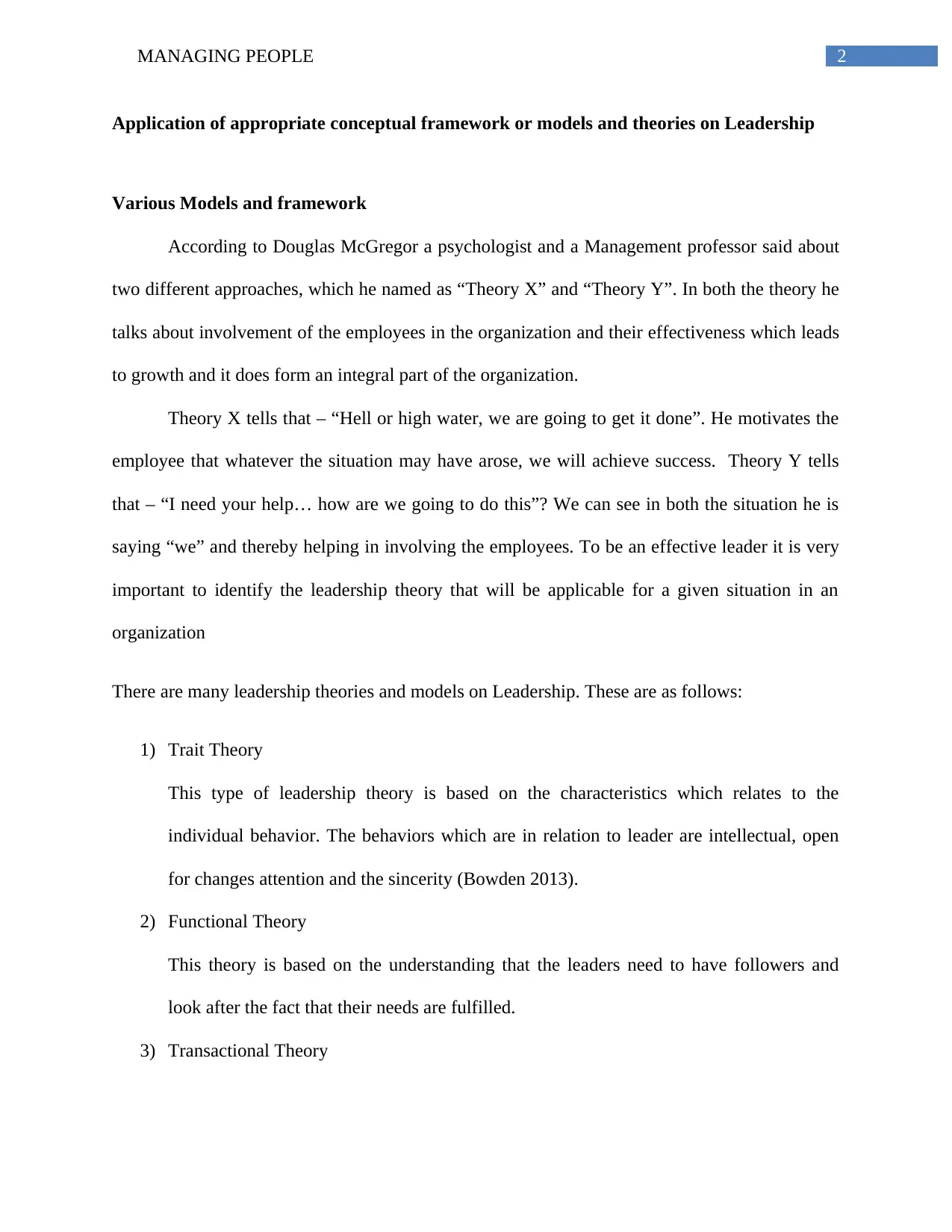
2MANAGING PEOPLE
Application of appropriate conceptual framework or models and theories on Leadership
Various Models and framework
According to Douglas McGregor a psychologist and a Management professor said about
two different approaches, which he named as “Theory X” and “Theory Y”. In both the theory he
talks about involvement of the employees in the organization and their effectiveness which leads
to growth and it does form an integral part of the organization.
Theory X tells that – “Hell or high water, we are going to get it done”. He motivates the
employee that whatever the situation may have arose, we will achieve success. Theory Y tells
that – “I need your help… how are we going to do this”? We can see in both the situation he is
saying “we” and thereby helping in involving the employees. To be an effective leader it is very
important to identify the leadership theory that will be applicable for a given situation in an
organization
There are many leadership theories and models on Leadership. These are as follows:
1) Trait Theory
This type of leadership theory is based on the characteristics which relates to the
individual behavior. The behaviors which are in relation to leader are intellectual, open
for changes attention and the sincerity (Bowden 2013).
2) Functional Theory
This theory is based on the understanding that the leaders need to have followers and
look after the fact that their needs are fulfilled.
3) Transactional Theory
Application of appropriate conceptual framework or models and theories on Leadership
Various Models and framework
According to Douglas McGregor a psychologist and a Management professor said about
two different approaches, which he named as “Theory X” and “Theory Y”. In both the theory he
talks about involvement of the employees in the organization and their effectiveness which leads
to growth and it does form an integral part of the organization.
Theory X tells that – “Hell or high water, we are going to get it done”. He motivates the
employee that whatever the situation may have arose, we will achieve success. Theory Y tells
that – “I need your help… how are we going to do this”? We can see in both the situation he is
saying “we” and thereby helping in involving the employees. To be an effective leader it is very
important to identify the leadership theory that will be applicable for a given situation in an
organization
There are many leadership theories and models on Leadership. These are as follows:
1) Trait Theory
This type of leadership theory is based on the characteristics which relates to the
individual behavior. The behaviors which are in relation to leader are intellectual, open
for changes attention and the sincerity (Bowden 2013).
2) Functional Theory
This theory is based on the understanding that the leaders need to have followers and
look after the fact that their needs are fulfilled.
3) Transactional Theory
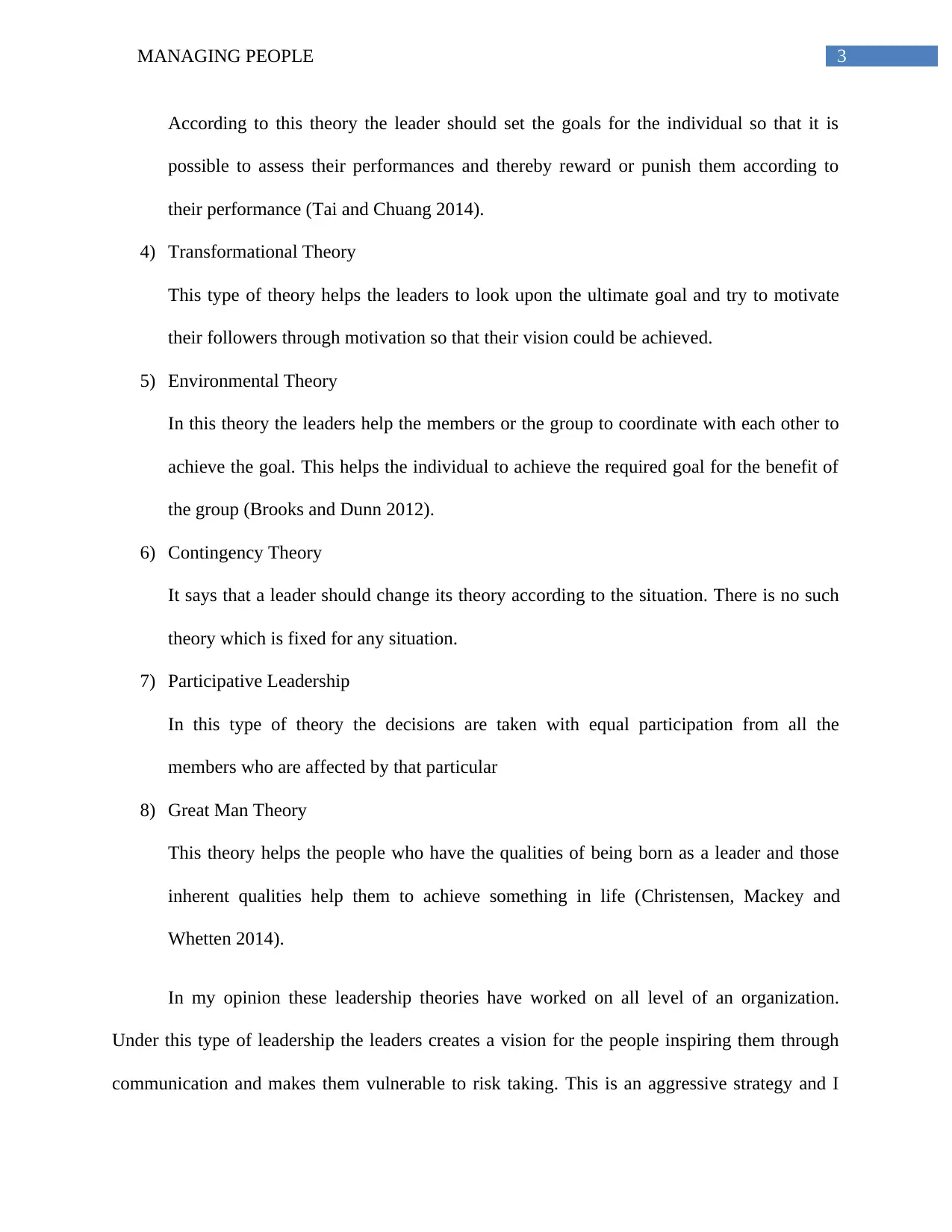
3MANAGING PEOPLE
According to this theory the leader should set the goals for the individual so that it is
possible to assess their performances and thereby reward or punish them according to
their performance (Tai and Chuang 2014).
4) Transformational Theory
This type of theory helps the leaders to look upon the ultimate goal and try to motivate
their followers through motivation so that their vision could be achieved.
5) Environmental Theory
In this theory the leaders help the members or the group to coordinate with each other to
achieve the goal. This helps the individual to achieve the required goal for the benefit of
the group (Brooks and Dunn 2012).
6) Contingency Theory
It says that a leader should change its theory according to the situation. There is no such
theory which is fixed for any situation.
7) Participative Leadership
In this type of theory the decisions are taken with equal participation from all the
members who are affected by that particular
8) Great Man Theory
This theory helps the people who have the qualities of being born as a leader and those
inherent qualities help them to achieve something in life (Christensen, Mackey and
Whetten 2014).
In my opinion these leadership theories have worked on all level of an organization.
Under this type of leadership the leaders creates a vision for the people inspiring them through
communication and makes them vulnerable to risk taking. This is an aggressive strategy and I
According to this theory the leader should set the goals for the individual so that it is
possible to assess their performances and thereby reward or punish them according to
their performance (Tai and Chuang 2014).
4) Transformational Theory
This type of theory helps the leaders to look upon the ultimate goal and try to motivate
their followers through motivation so that their vision could be achieved.
5) Environmental Theory
In this theory the leaders help the members or the group to coordinate with each other to
achieve the goal. This helps the individual to achieve the required goal for the benefit of
the group (Brooks and Dunn 2012).
6) Contingency Theory
It says that a leader should change its theory according to the situation. There is no such
theory which is fixed for any situation.
7) Participative Leadership
In this type of theory the decisions are taken with equal participation from all the
members who are affected by that particular
8) Great Man Theory
This theory helps the people who have the qualities of being born as a leader and those
inherent qualities help them to achieve something in life (Christensen, Mackey and
Whetten 2014).
In my opinion these leadership theories have worked on all level of an organization.
Under this type of leadership the leaders creates a vision for the people inspiring them through
communication and makes them vulnerable to risk taking. This is an aggressive strategy and I
Secure Best Marks with AI Grader
Need help grading? Try our AI Grader for instant feedback on your assignments.
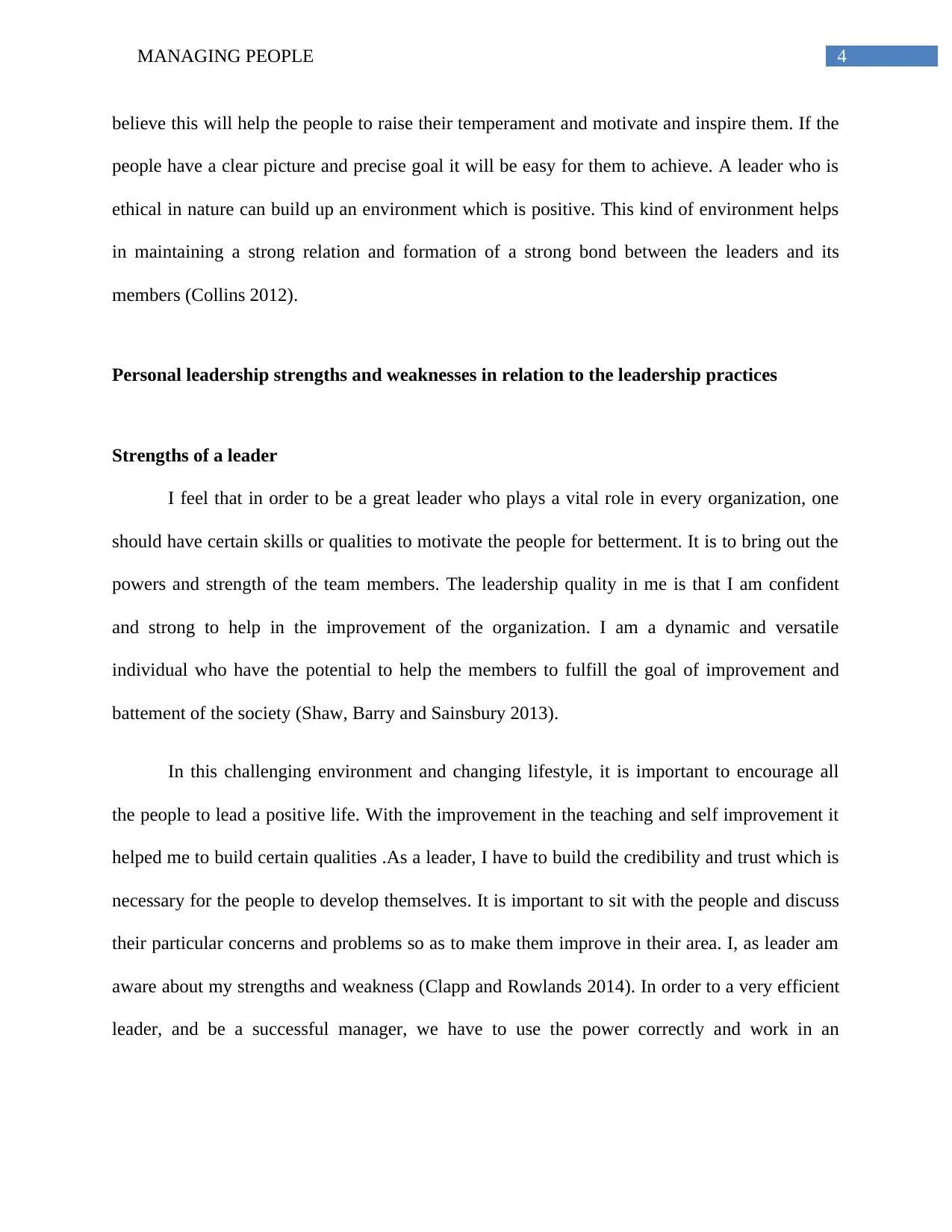
4MANAGING PEOPLE
believe this will help the people to raise their temperament and motivate and inspire them. If the
people have a clear picture and precise goal it will be easy for them to achieve. A leader who is
ethical in nature can build up an environment which is positive. This kind of environment helps
in maintaining a strong relation and formation of a strong bond between the leaders and its
members (Collins 2012).
Personal leadership strengths and weaknesses in relation to the leadership practices
Strengths of a leader
I feel that in order to be a great leader who plays a vital role in every organization, one
should have certain skills or qualities to motivate the people for betterment. It is to bring out the
powers and strength of the team members. The leadership quality in me is that I am confident
and strong to help in the improvement of the organization. I am a dynamic and versatile
individual who have the potential to help the members to fulfill the goal of improvement and
battement of the society (Shaw, Barry and Sainsbury 2013).
In this challenging environment and changing lifestyle, it is important to encourage all
the people to lead a positive life. With the improvement in the teaching and self improvement it
helped me to build certain qualities .As a leader, I have to build the credibility and trust which is
necessary for the people to develop themselves. It is important to sit with the people and discuss
their particular concerns and problems so as to make them improve in their area. I, as leader am
aware about my strengths and weakness (Clapp and Rowlands 2014). In order to a very efficient
leader, and be a successful manager, we have to use the power correctly and work in an
believe this will help the people to raise their temperament and motivate and inspire them. If the
people have a clear picture and precise goal it will be easy for them to achieve. A leader who is
ethical in nature can build up an environment which is positive. This kind of environment helps
in maintaining a strong relation and formation of a strong bond between the leaders and its
members (Collins 2012).
Personal leadership strengths and weaknesses in relation to the leadership practices
Strengths of a leader
I feel that in order to be a great leader who plays a vital role in every organization, one
should have certain skills or qualities to motivate the people for betterment. It is to bring out the
powers and strength of the team members. The leadership quality in me is that I am confident
and strong to help in the improvement of the organization. I am a dynamic and versatile
individual who have the potential to help the members to fulfill the goal of improvement and
battement of the society (Shaw, Barry and Sainsbury 2013).
In this challenging environment and changing lifestyle, it is important to encourage all
the people to lead a positive life. With the improvement in the teaching and self improvement it
helped me to build certain qualities .As a leader, I have to build the credibility and trust which is
necessary for the people to develop themselves. It is important to sit with the people and discuss
their particular concerns and problems so as to make them improve in their area. I, as leader am
aware about my strengths and weakness (Clapp and Rowlands 2014). In order to a very efficient
leader, and be a successful manager, we have to use the power correctly and work in an
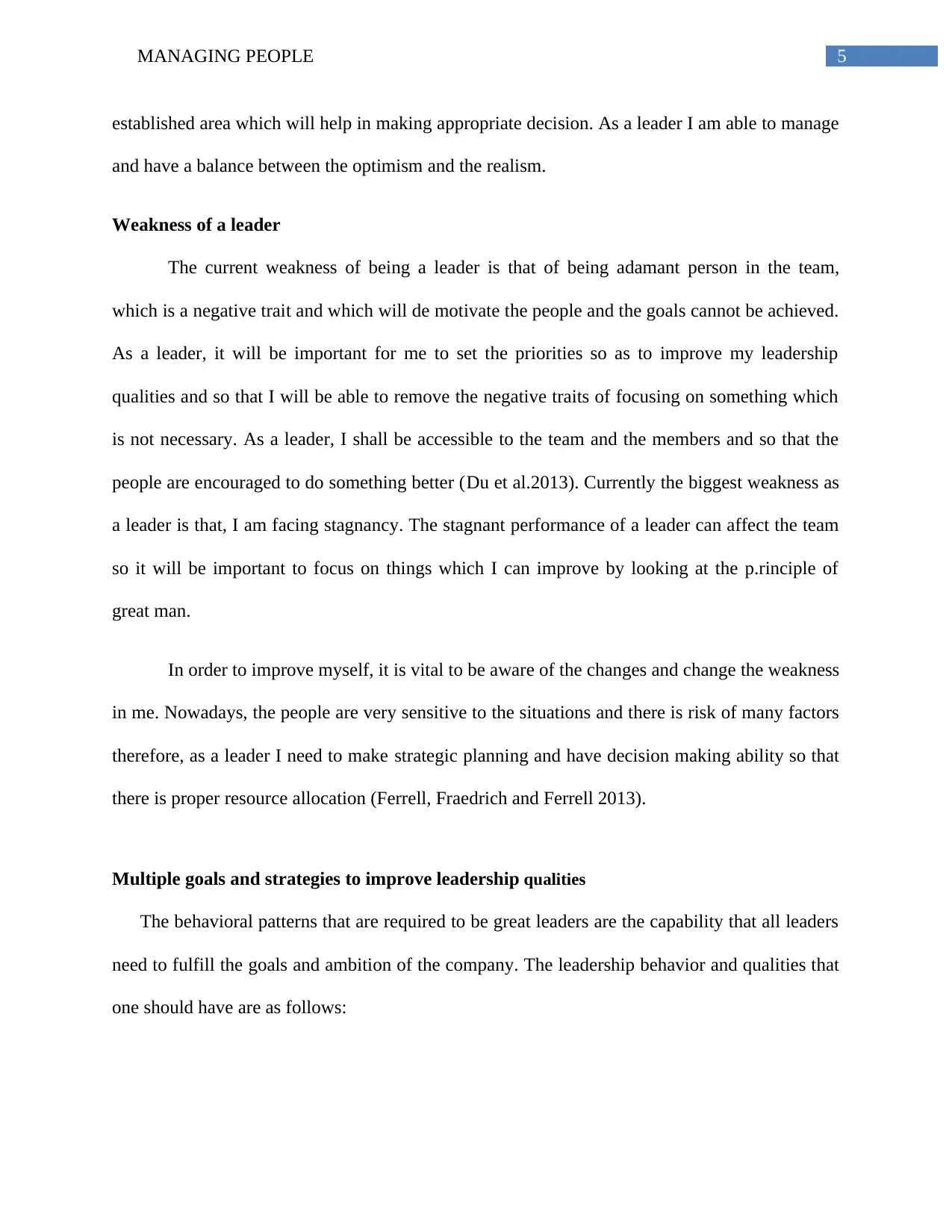
5MANAGING PEOPLE
established area which will help in making appropriate decision. As a leader I am able to manage
and have a balance between the optimism and the realism.
Weakness of a leader
The current weakness of being a leader is that of being adamant person in the team,
which is a negative trait and which will de motivate the people and the goals cannot be achieved.
As a leader, it will be important for me to set the priorities so as to improve my leadership
qualities and so that I will be able to remove the negative traits of focusing on something which
is not necessary. As a leader, I shall be accessible to the team and the members and so that the
people are encouraged to do something better (Du et al.2013). Currently the biggest weakness as
a leader is that, I am facing stagnancy. The stagnant performance of a leader can affect the team
so it will be important to focus on things which I can improve by looking at the p.rinciple of
great man.
In order to improve myself, it is vital to be aware of the changes and change the weakness
in me. Nowadays, the people are very sensitive to the situations and there is risk of many factors
therefore, as a leader I need to make strategic planning and have decision making ability so that
there is proper resource allocation (Ferrell, Fraedrich and Ferrell 2013).
Multiple goals and strategies to improve leadership qualities
The behavioral patterns that are required to be great leaders are the capability that all leaders
need to fulfill the goals and ambition of the company. The leadership behavior and qualities that
one should have are as follows:
established area which will help in making appropriate decision. As a leader I am able to manage
and have a balance between the optimism and the realism.
Weakness of a leader
The current weakness of being a leader is that of being adamant person in the team,
which is a negative trait and which will de motivate the people and the goals cannot be achieved.
As a leader, it will be important for me to set the priorities so as to improve my leadership
qualities and so that I will be able to remove the negative traits of focusing on something which
is not necessary. As a leader, I shall be accessible to the team and the members and so that the
people are encouraged to do something better (Du et al.2013). Currently the biggest weakness as
a leader is that, I am facing stagnancy. The stagnant performance of a leader can affect the team
so it will be important to focus on things which I can improve by looking at the p.rinciple of
great man.
In order to improve myself, it is vital to be aware of the changes and change the weakness
in me. Nowadays, the people are very sensitive to the situations and there is risk of many factors
therefore, as a leader I need to make strategic planning and have decision making ability so that
there is proper resource allocation (Ferrell, Fraedrich and Ferrell 2013).
Multiple goals and strategies to improve leadership qualities
The behavioral patterns that are required to be great leaders are the capability that all leaders
need to fulfill the goals and ambition of the company. The leadership behavior and qualities that
one should have are as follows:
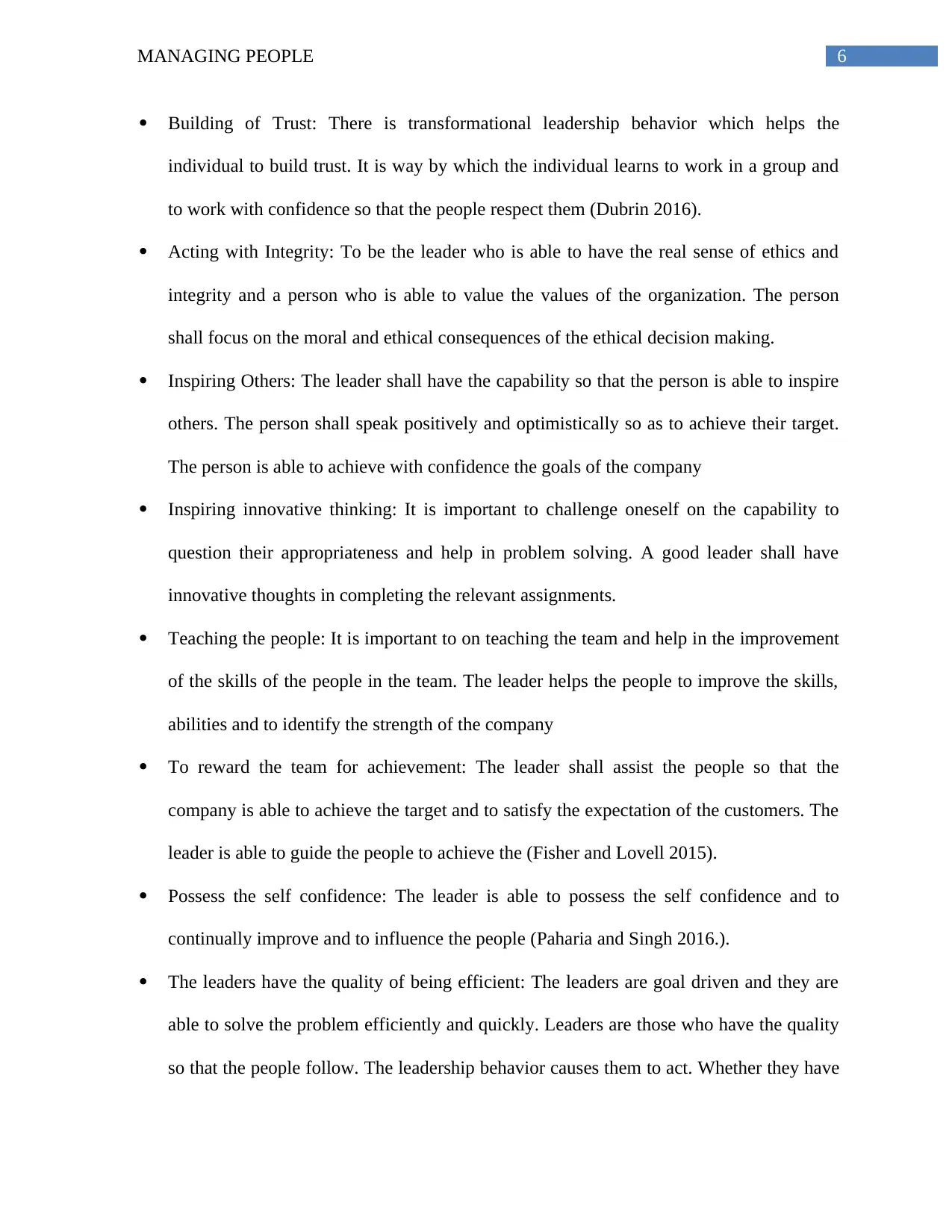
6MANAGING PEOPLE
Building of Trust: There is transformational leadership behavior which helps the
individual to build trust. It is way by which the individual learns to work in a group and
to work with confidence so that the people respect them (Dubrin 2016).
Acting with Integrity: To be the leader who is able to have the real sense of ethics and
integrity and a person who is able to value the values of the organization. The person
shall focus on the moral and ethical consequences of the ethical decision making.
Inspiring Others: The leader shall have the capability so that the person is able to inspire
others. The person shall speak positively and optimistically so as to achieve their target.
The person is able to achieve with confidence the goals of the company
Inspiring innovative thinking: It is important to challenge oneself on the capability to
question their appropriateness and help in problem solving. A good leader shall have
innovative thoughts in completing the relevant assignments.
Teaching the people: It is important to on teaching the team and help in the improvement
of the skills of the people in the team. The leader helps the people to improve the skills,
abilities and to identify the strength of the company
To reward the team for achievement: The leader shall assist the people so that the
company is able to achieve the target and to satisfy the expectation of the customers. The
leader is able to guide the people to achieve the (Fisher and Lovell 2015).
Possess the self confidence: The leader is able to possess the self confidence and to
continually improve and to influence the people (Paharia and Singh 2016.).
The leaders have the quality of being efficient: The leaders are goal driven and they are
able to solve the problem efficiently and quickly. Leaders are those who have the quality
so that the people follow. The leadership behavior causes them to act. Whether they have
Building of Trust: There is transformational leadership behavior which helps the
individual to build trust. It is way by which the individual learns to work in a group and
to work with confidence so that the people respect them (Dubrin 2016).
Acting with Integrity: To be the leader who is able to have the real sense of ethics and
integrity and a person who is able to value the values of the organization. The person
shall focus on the moral and ethical consequences of the ethical decision making.
Inspiring Others: The leader shall have the capability so that the person is able to inspire
others. The person shall speak positively and optimistically so as to achieve their target.
The person is able to achieve with confidence the goals of the company
Inspiring innovative thinking: It is important to challenge oneself on the capability to
question their appropriateness and help in problem solving. A good leader shall have
innovative thoughts in completing the relevant assignments.
Teaching the people: It is important to on teaching the team and help in the improvement
of the skills of the people in the team. The leader helps the people to improve the skills,
abilities and to identify the strength of the company
To reward the team for achievement: The leader shall assist the people so that the
company is able to achieve the target and to satisfy the expectation of the customers. The
leader is able to guide the people to achieve the (Fisher and Lovell 2015).
Possess the self confidence: The leader is able to possess the self confidence and to
continually improve and to influence the people (Paharia and Singh 2016.).
The leaders have the quality of being efficient: The leaders are goal driven and they are
able to solve the problem efficiently and quickly. Leaders are those who have the quality
so that the people follow. The leadership behavior causes them to act. Whether they have
Paraphrase This Document
Need a fresh take? Get an instant paraphrase of this document with our AI Paraphraser
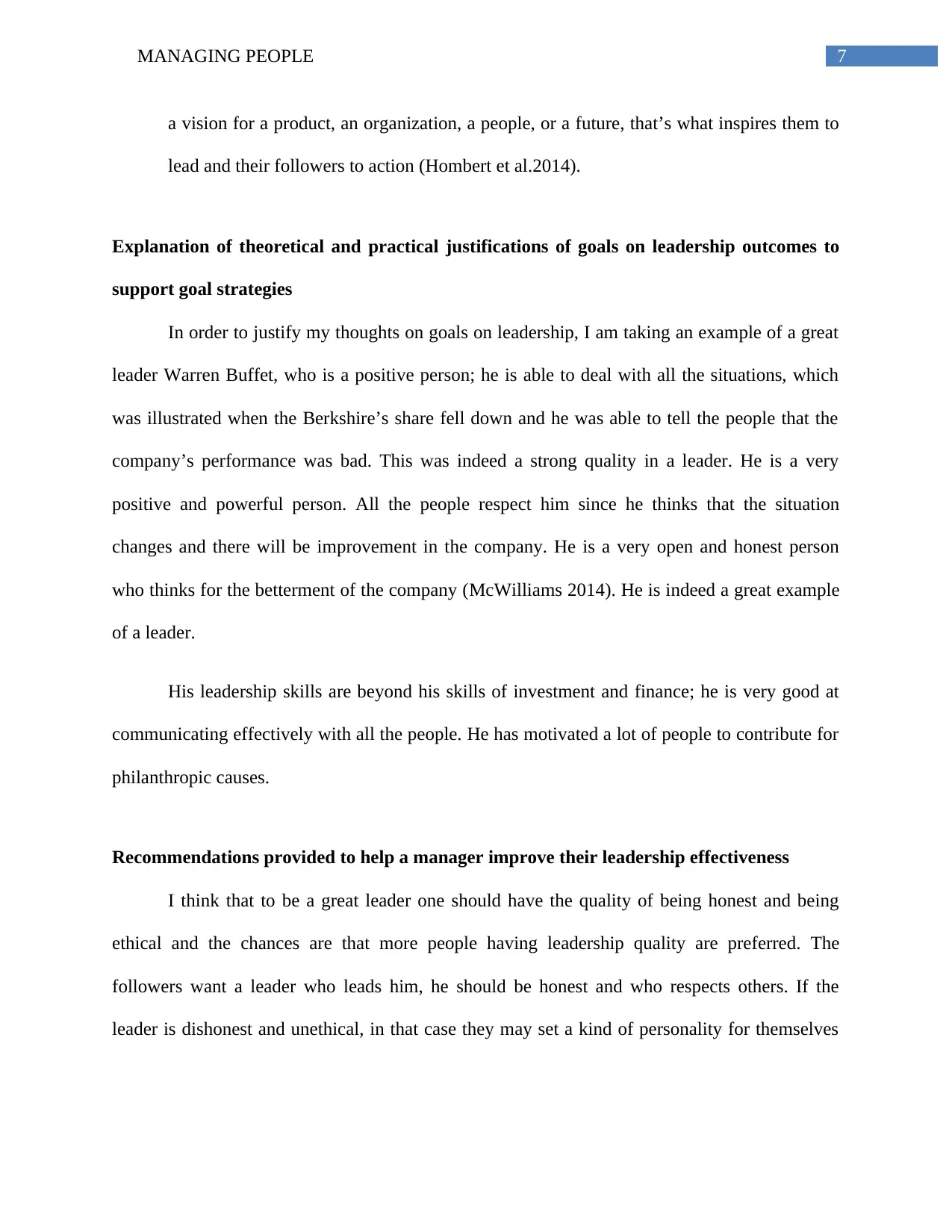
7MANAGING PEOPLE
a vision for a product, an organization, a people, or a future, that’s what inspires them to
lead and their followers to action (Hombert et al.2014).
Explanation of theoretical and practical justifications of goals on leadership outcomes to
support goal strategies
In order to justify my thoughts on goals on leadership, I am taking an example of a great
leader Warren Buffet, who is a positive person; he is able to deal with all the situations, which
was illustrated when the Berkshire’s share fell down and he was able to tell the people that the
company’s performance was bad. This was indeed a strong quality in a leader. He is a very
positive and powerful person. All the people respect him since he thinks that the situation
changes and there will be improvement in the company. He is a very open and honest person
who thinks for the betterment of the company (McWilliams 2014). He is indeed a great example
of a leader.
His leadership skills are beyond his skills of investment and finance; he is very good at
communicating effectively with all the people. He has motivated a lot of people to contribute for
philanthropic causes.
Recommendations provided to help a manager improve their leadership effectiveness
I think that to be a great leader one should have the quality of being honest and being
ethical and the chances are that more people having leadership quality are preferred. The
followers want a leader who leads him, he should be honest and who respects others. If the
leader is dishonest and unethical, in that case they may set a kind of personality for themselves
a vision for a product, an organization, a people, or a future, that’s what inspires them to
lead and their followers to action (Hombert et al.2014).
Explanation of theoretical and practical justifications of goals on leadership outcomes to
support goal strategies
In order to justify my thoughts on goals on leadership, I am taking an example of a great
leader Warren Buffet, who is a positive person; he is able to deal with all the situations, which
was illustrated when the Berkshire’s share fell down and he was able to tell the people that the
company’s performance was bad. This was indeed a strong quality in a leader. He is a very
positive and powerful person. All the people respect him since he thinks that the situation
changes and there will be improvement in the company. He is a very open and honest person
who thinks for the betterment of the company (McWilliams 2014). He is indeed a great example
of a leader.
His leadership skills are beyond his skills of investment and finance; he is very good at
communicating effectively with all the people. He has motivated a lot of people to contribute for
philanthropic causes.
Recommendations provided to help a manager improve their leadership effectiveness
I think that to be a great leader one should have the quality of being honest and being
ethical and the chances are that more people having leadership quality are preferred. The
followers want a leader who leads him, he should be honest and who respects others. If the
leader is dishonest and unethical, in that case they may set a kind of personality for themselves
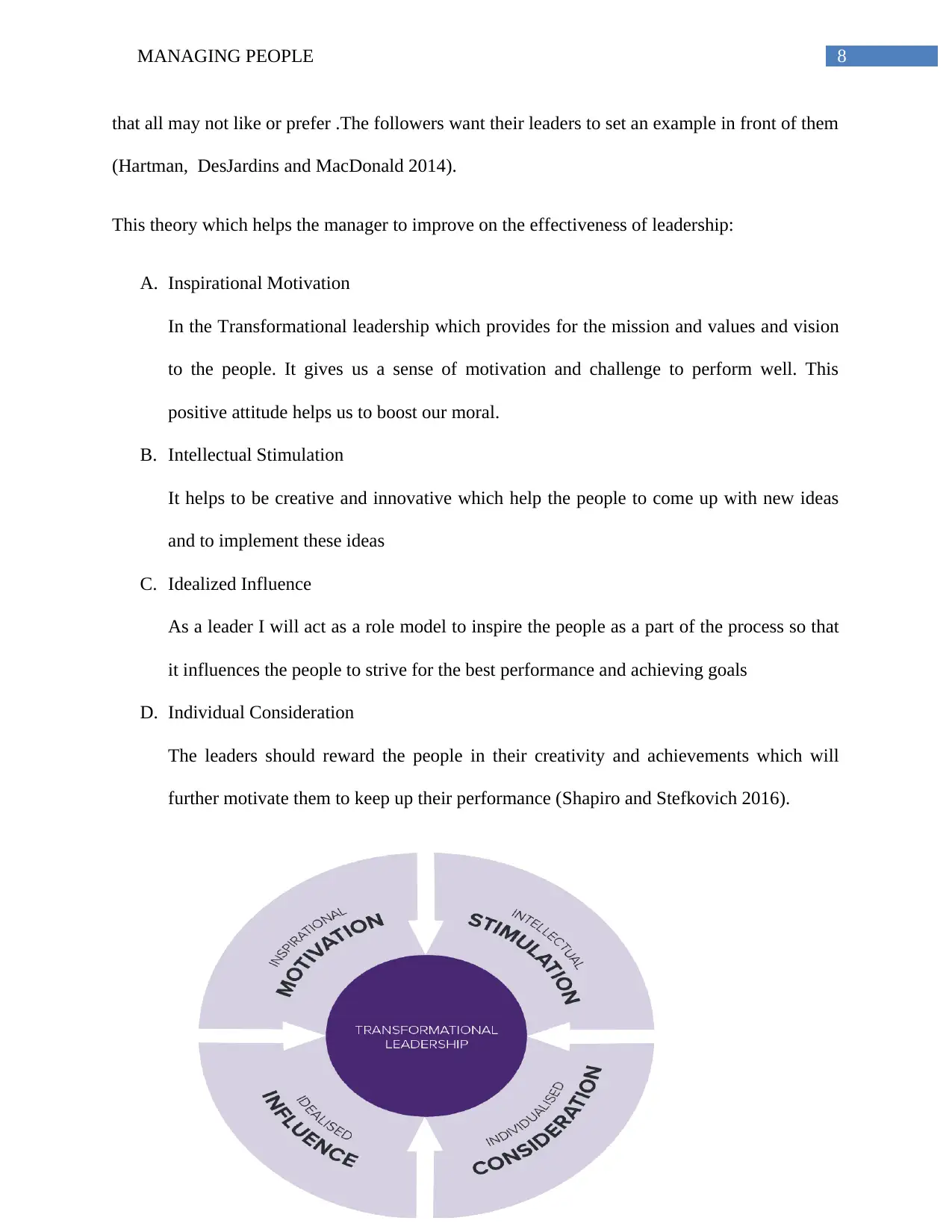
8MANAGING PEOPLE
that all may not like or prefer .The followers want their leaders to set an example in front of them
(Hartman, DesJardins and MacDonald 2014).
This theory which helps the manager to improve on the effectiveness of leadership:
A. Inspirational Motivation
In the Transformational leadership which provides for the mission and values and vision
to the people. It gives us a sense of motivation and challenge to perform well. This
positive attitude helps us to boost our moral.
B. Intellectual Stimulation
It helps to be creative and innovative which help the people to come up with new ideas
and to implement these ideas
C. Idealized Influence
As a leader I will act as a role model to inspire the people as a part of the process so that
it influences the people to strive for the best performance and achieving goals
D. Individual Consideration
The leaders should reward the people in their creativity and achievements which will
further motivate them to keep up their performance (Shapiro and Stefkovich 2016).
that all may not like or prefer .The followers want their leaders to set an example in front of them
(Hartman, DesJardins and MacDonald 2014).
This theory which helps the manager to improve on the effectiveness of leadership:
A. Inspirational Motivation
In the Transformational leadership which provides for the mission and values and vision
to the people. It gives us a sense of motivation and challenge to perform well. This
positive attitude helps us to boost our moral.
B. Intellectual Stimulation
It helps to be creative and innovative which help the people to come up with new ideas
and to implement these ideas
C. Idealized Influence
As a leader I will act as a role model to inspire the people as a part of the process so that
it influences the people to strive for the best performance and achieving goals
D. Individual Consideration
The leaders should reward the people in their creativity and achievements which will
further motivate them to keep up their performance (Shapiro and Stefkovich 2016).
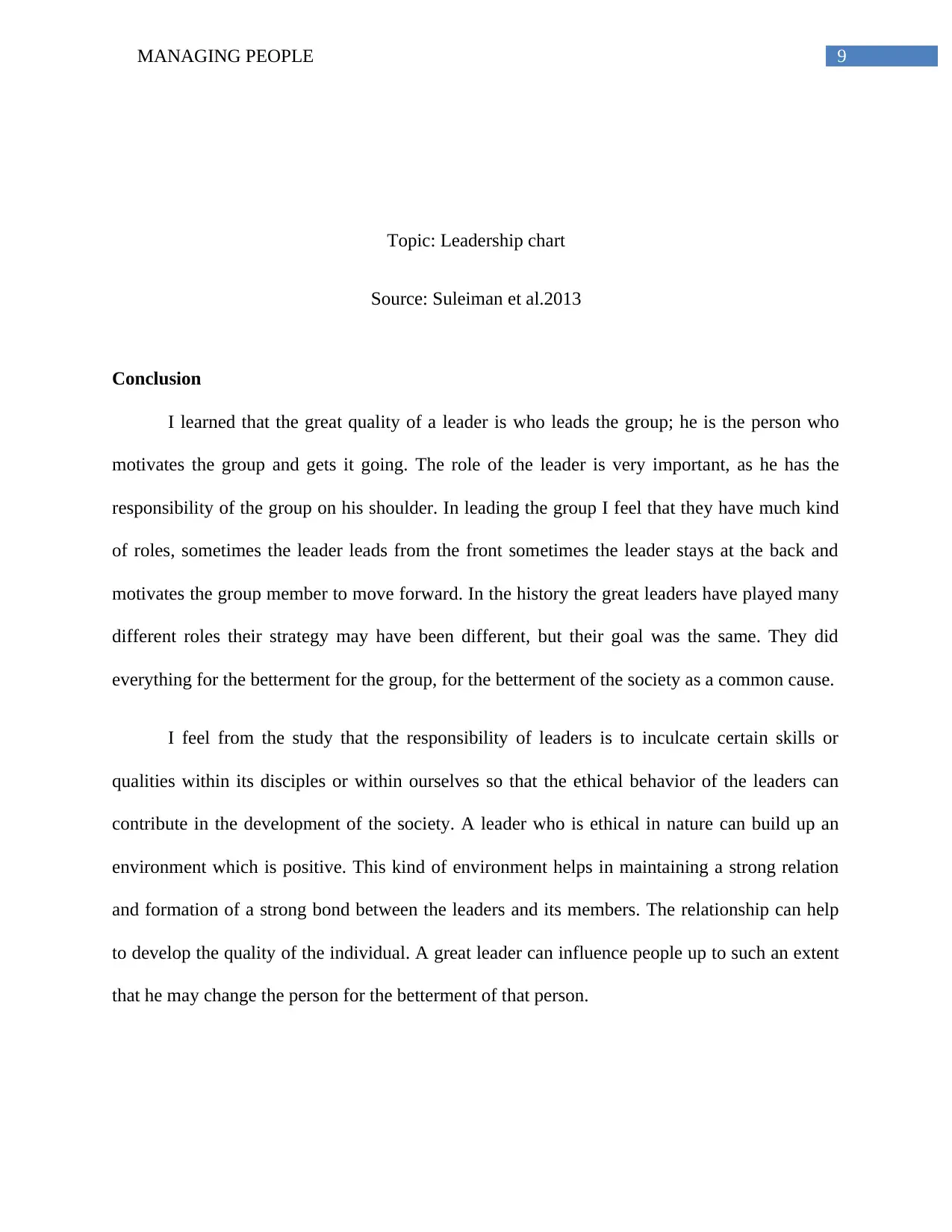
9MANAGING PEOPLE
Topic: Leadership chart
Source: Suleiman et al.2013
Conclusion
I learned that the great quality of a leader is who leads the group; he is the person who
motivates the group and gets it going. The role of the leader is very important, as he has the
responsibility of the group on his shoulder. In leading the group I feel that they have much kind
of roles, sometimes the leader leads from the front sometimes the leader stays at the back and
motivates the group member to move forward. In the history the great leaders have played many
different roles their strategy may have been different, but their goal was the same. They did
everything for the betterment for the group, for the betterment of the society as a common cause.
I feel from the study that the responsibility of leaders is to inculcate certain skills or
qualities within its disciples or within ourselves so that the ethical behavior of the leaders can
contribute in the development of the society. A leader who is ethical in nature can build up an
environment which is positive. This kind of environment helps in maintaining a strong relation
and formation of a strong bond between the leaders and its members. The relationship can help
to develop the quality of the individual. A great leader can influence people up to such an extent
that he may change the person for the betterment of that person.
Topic: Leadership chart
Source: Suleiman et al.2013
Conclusion
I learned that the great quality of a leader is who leads the group; he is the person who
motivates the group and gets it going. The role of the leader is very important, as he has the
responsibility of the group on his shoulder. In leading the group I feel that they have much kind
of roles, sometimes the leader leads from the front sometimes the leader stays at the back and
motivates the group member to move forward. In the history the great leaders have played many
different roles their strategy may have been different, but their goal was the same. They did
everything for the betterment for the group, for the betterment of the society as a common cause.
I feel from the study that the responsibility of leaders is to inculcate certain skills or
qualities within its disciples or within ourselves so that the ethical behavior of the leaders can
contribute in the development of the society. A leader who is ethical in nature can build up an
environment which is positive. This kind of environment helps in maintaining a strong relation
and formation of a strong bond between the leaders and its members. The relationship can help
to develop the quality of the individual. A great leader can influence people up to such an extent
that he may change the person for the betterment of that person.
Secure Best Marks with AI Grader
Need help grading? Try our AI Grader for instant feedback on your assignments.
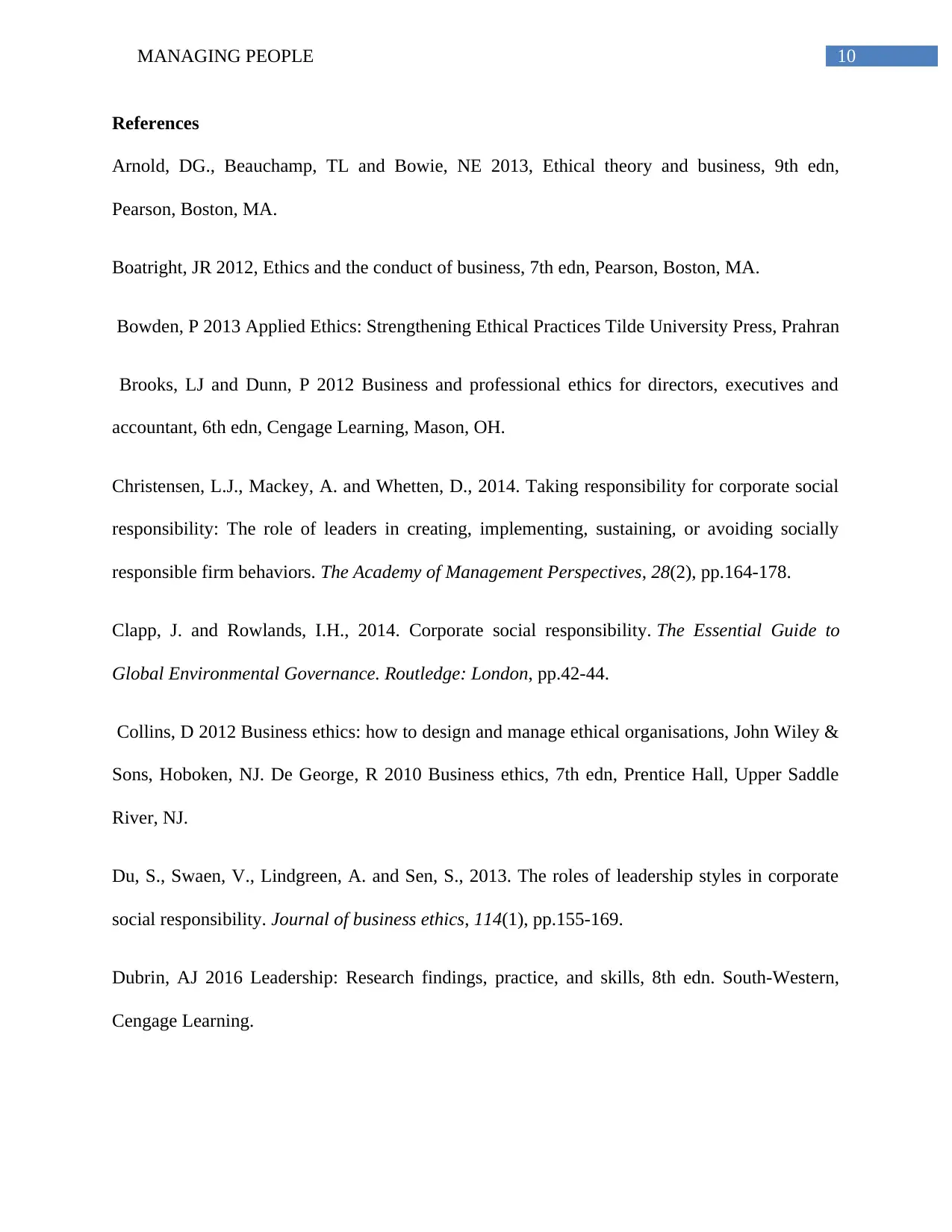
10MANAGING PEOPLE
References
Arnold, DG., Beauchamp, TL and Bowie, NE 2013, Ethical theory and business, 9th edn,
Pearson, Boston, MA.
Boatright, JR 2012, Ethics and the conduct of business, 7th edn, Pearson, Boston, MA.
Bowden, P 2013 Applied Ethics: Strengthening Ethical Practices Tilde University Press, Prahran
Brooks, LJ and Dunn, P 2012 Business and professional ethics for directors, executives and
accountant, 6th edn, Cengage Learning, Mason, OH.
Christensen, L.J., Mackey, A. and Whetten, D., 2014. Taking responsibility for corporate social
responsibility: The role of leaders in creating, implementing, sustaining, or avoiding socially
responsible firm behaviors. The Academy of Management Perspectives, 28(2), pp.164-178.
Clapp, J. and Rowlands, I.H., 2014. Corporate social responsibility. The Essential Guide to
Global Environmental Governance. Routledge: London, pp.42-44.
Collins, D 2012 Business ethics: how to design and manage ethical organisations, John Wiley &
Sons, Hoboken, NJ. De George, R 2010 Business ethics, 7th edn, Prentice Hall, Upper Saddle
River, NJ.
Du, S., Swaen, V., Lindgreen, A. and Sen, S., 2013. The roles of leadership styles in corporate
social responsibility. Journal of business ethics, 114(1), pp.155-169.
Dubrin, AJ 2016 Leadership: Research findings, practice, and skills, 8th edn. South-Western,
Cengage Learning.
References
Arnold, DG., Beauchamp, TL and Bowie, NE 2013, Ethical theory and business, 9th edn,
Pearson, Boston, MA.
Boatright, JR 2012, Ethics and the conduct of business, 7th edn, Pearson, Boston, MA.
Bowden, P 2013 Applied Ethics: Strengthening Ethical Practices Tilde University Press, Prahran
Brooks, LJ and Dunn, P 2012 Business and professional ethics for directors, executives and
accountant, 6th edn, Cengage Learning, Mason, OH.
Christensen, L.J., Mackey, A. and Whetten, D., 2014. Taking responsibility for corporate social
responsibility: The role of leaders in creating, implementing, sustaining, or avoiding socially
responsible firm behaviors. The Academy of Management Perspectives, 28(2), pp.164-178.
Clapp, J. and Rowlands, I.H., 2014. Corporate social responsibility. The Essential Guide to
Global Environmental Governance. Routledge: London, pp.42-44.
Collins, D 2012 Business ethics: how to design and manage ethical organisations, John Wiley &
Sons, Hoboken, NJ. De George, R 2010 Business ethics, 7th edn, Prentice Hall, Upper Saddle
River, NJ.
Du, S., Swaen, V., Lindgreen, A. and Sen, S., 2013. The roles of leadership styles in corporate
social responsibility. Journal of business ethics, 114(1), pp.155-169.
Dubrin, AJ 2016 Leadership: Research findings, practice, and skills, 8th edn. South-Western,
Cengage Learning.
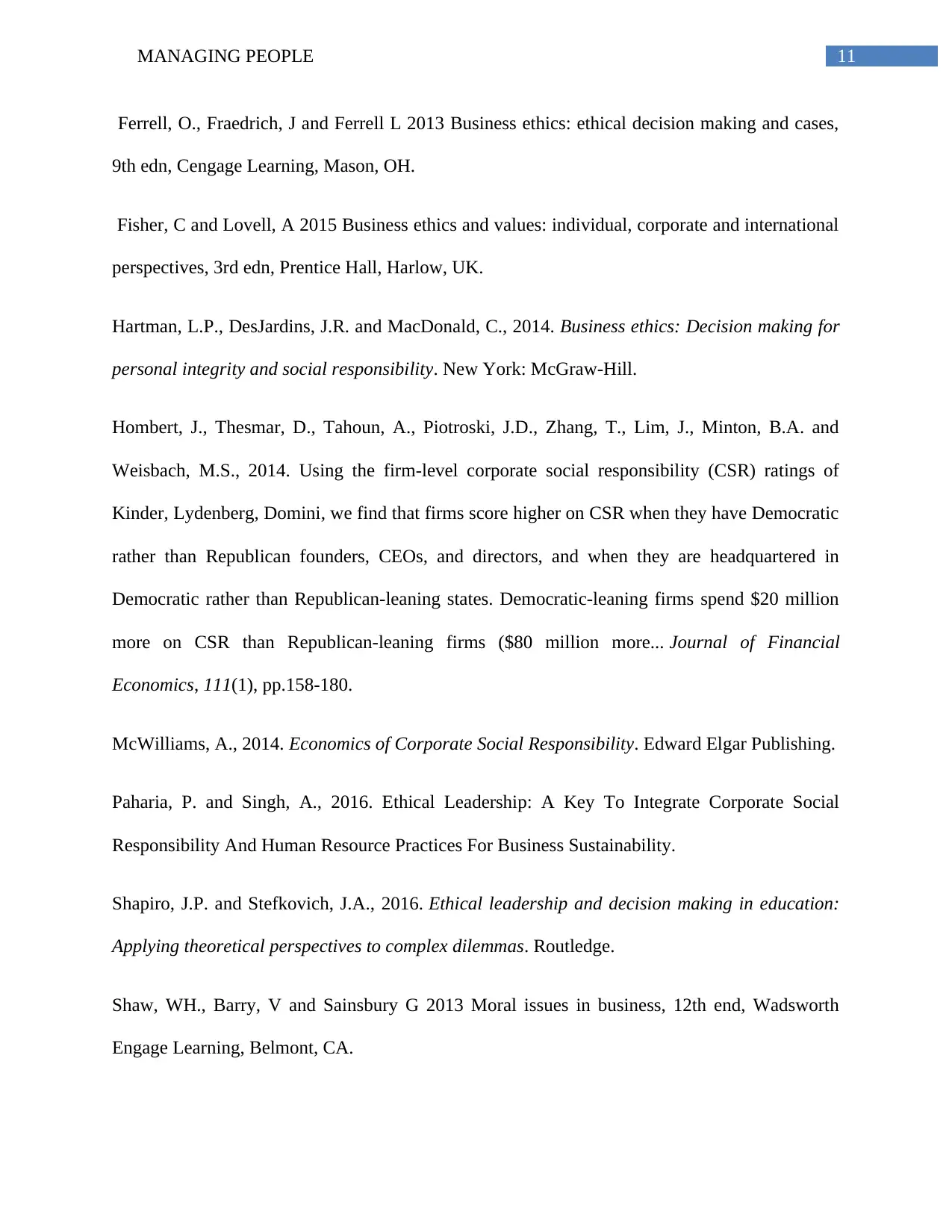
11MANAGING PEOPLE
Ferrell, O., Fraedrich, J and Ferrell L 2013 Business ethics: ethical decision making and cases,
9th edn, Cengage Learning, Mason, OH.
Fisher, C and Lovell, A 2015 Business ethics and values: individual, corporate and international
perspectives, 3rd edn, Prentice Hall, Harlow, UK.
Hartman, L.P., DesJardins, J.R. and MacDonald, C., 2014. Business ethics: Decision making for
personal integrity and social responsibility. New York: McGraw-Hill.
Hombert, J., Thesmar, D., Tahoun, A., Piotroski, J.D., Zhang, T., Lim, J., Minton, B.A. and
Weisbach, M.S., 2014. Using the firm-level corporate social responsibility (CSR) ratings of
Kinder, Lydenberg, Domini, we find that firms score higher on CSR when they have Democratic
rather than Republican founders, CEOs, and directors, and when they are headquartered in
Democratic rather than Republican-leaning states. Democratic-leaning firms spend $20 million
more on CSR than Republican-leaning firms ($80 million more... Journal of Financial
Economics, 111(1), pp.158-180.
McWilliams, A., 2014. Economics of Corporate Social Responsibility. Edward Elgar Publishing.
Paharia, P. and Singh, A., 2016. Ethical Leadership: A Key To Integrate Corporate Social
Responsibility And Human Resource Practices For Business Sustainability.
Shapiro, J.P. and Stefkovich, J.A., 2016. Ethical leadership and decision making in education:
Applying theoretical perspectives to complex dilemmas. Routledge.
Shaw, WH., Barry, V and Sainsbury G 2013 Moral issues in business, 12th end, Wadsworth
Engage Learning, Belmont, CA.
Ferrell, O., Fraedrich, J and Ferrell L 2013 Business ethics: ethical decision making and cases,
9th edn, Cengage Learning, Mason, OH.
Fisher, C and Lovell, A 2015 Business ethics and values: individual, corporate and international
perspectives, 3rd edn, Prentice Hall, Harlow, UK.
Hartman, L.P., DesJardins, J.R. and MacDonald, C., 2014. Business ethics: Decision making for
personal integrity and social responsibility. New York: McGraw-Hill.
Hombert, J., Thesmar, D., Tahoun, A., Piotroski, J.D., Zhang, T., Lim, J., Minton, B.A. and
Weisbach, M.S., 2014. Using the firm-level corporate social responsibility (CSR) ratings of
Kinder, Lydenberg, Domini, we find that firms score higher on CSR when they have Democratic
rather than Republican founders, CEOs, and directors, and when they are headquartered in
Democratic rather than Republican-leaning states. Democratic-leaning firms spend $20 million
more on CSR than Republican-leaning firms ($80 million more... Journal of Financial
Economics, 111(1), pp.158-180.
McWilliams, A., 2014. Economics of Corporate Social Responsibility. Edward Elgar Publishing.
Paharia, P. and Singh, A., 2016. Ethical Leadership: A Key To Integrate Corporate Social
Responsibility And Human Resource Practices For Business Sustainability.
Shapiro, J.P. and Stefkovich, J.A., 2016. Ethical leadership and decision making in education:
Applying theoretical perspectives to complex dilemmas. Routledge.
Shaw, WH., Barry, V and Sainsbury G 2013 Moral issues in business, 12th end, Wadsworth
Engage Learning, Belmont, CA.
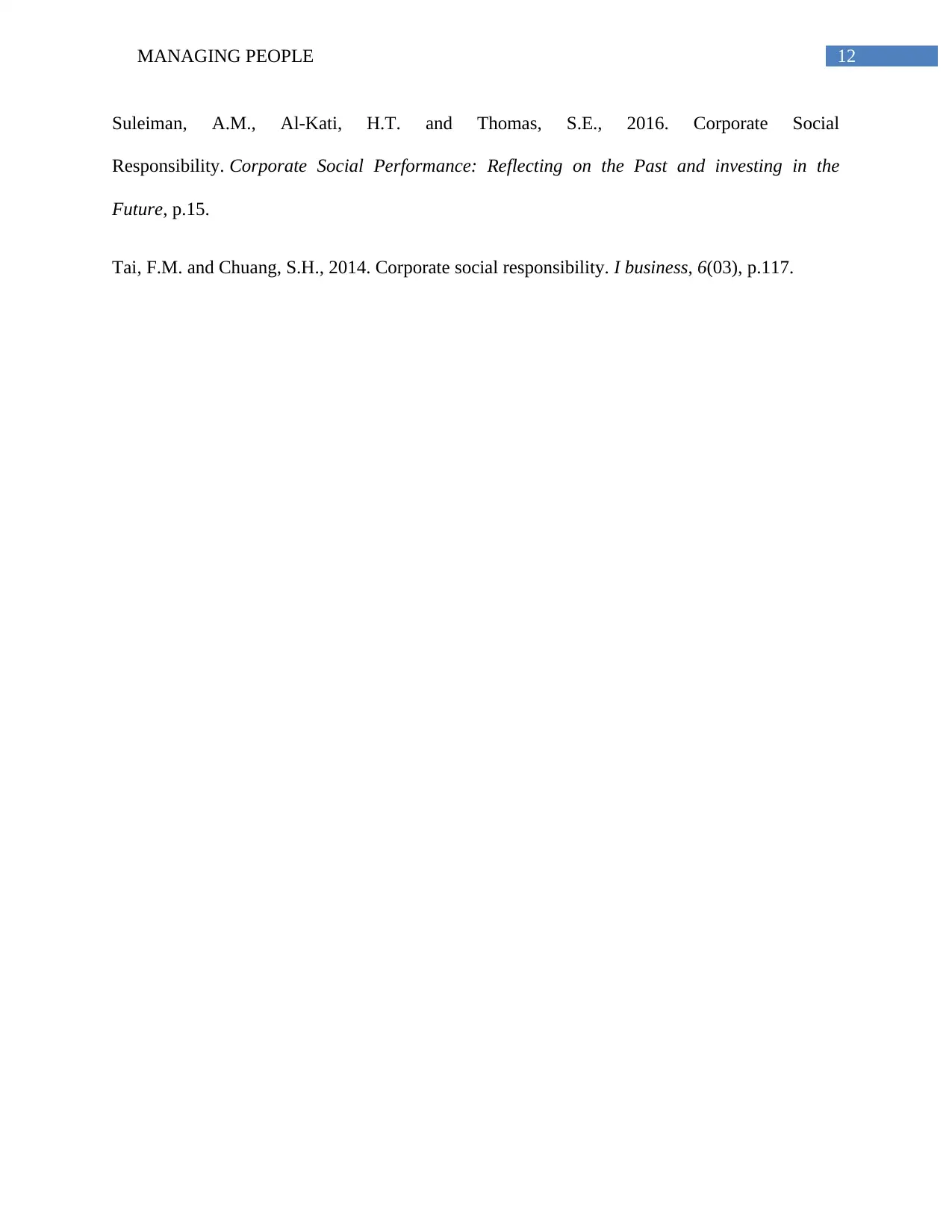
12MANAGING PEOPLE
Suleiman, A.M., Al-Kati, H.T. and Thomas, S.E., 2016. Corporate Social
Responsibility. Corporate Social Performance: Reflecting on the Past and investing in the
Future, p.15.
Tai, F.M. and Chuang, S.H., 2014. Corporate social responsibility. I business, 6(03), p.117.
Suleiman, A.M., Al-Kati, H.T. and Thomas, S.E., 2016. Corporate Social
Responsibility. Corporate Social Performance: Reflecting on the Past and investing in the
Future, p.15.
Tai, F.M. and Chuang, S.H., 2014. Corporate social responsibility. I business, 6(03), p.117.
1 out of 13
Related Documents
Your All-in-One AI-Powered Toolkit for Academic Success.
+13062052269
info@desklib.com
Available 24*7 on WhatsApp / Email
![[object Object]](/_next/static/media/star-bottom.7253800d.svg)
Unlock your academic potential
© 2024 | Zucol Services PVT LTD | All rights reserved.





